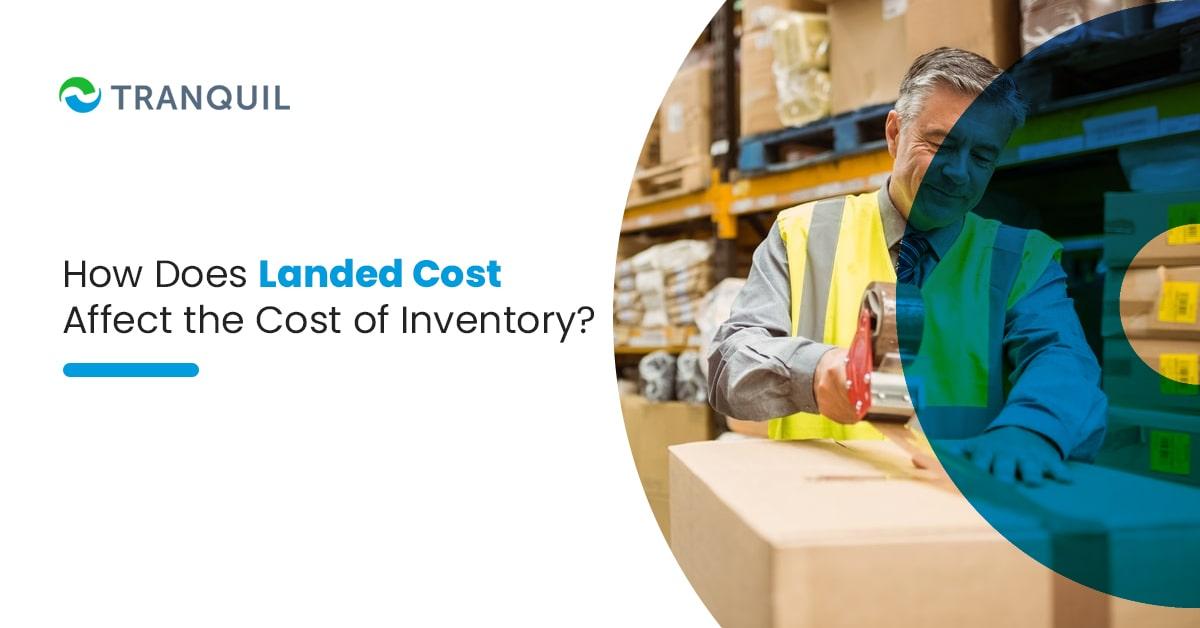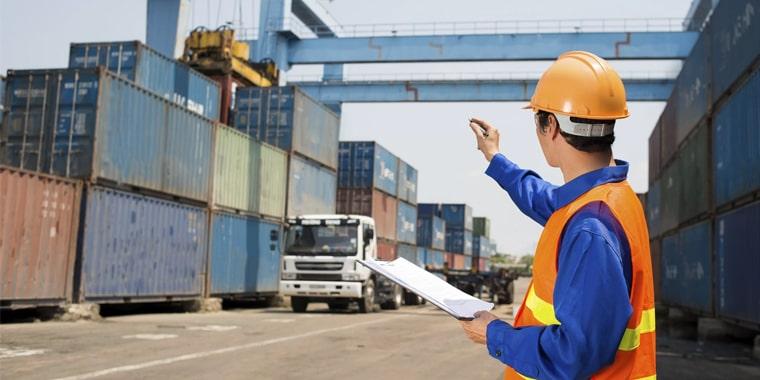
As a business owner, you would naturally look for the best deals on raw materials or products – and you may find them with an overseas supplier. But before you sign the dotted line, stop and think how much it will actually cost to get the products to your warehouse from your supplier.
It’s not just the cost of the goods itself; you will have to bear other costs too.
To get a clear idea of the cost of shipping the goods from your supplier, you have to calculate landed cost of the goods.
ALSO READ: What is Negative Inventory and How Can you Prevent it?
The landed cost simply means the total cost you incur to get a product from the supplier to your warehouse/store.
To arrive at this cost, you will have to add shipping and freight charges, commissions, customs duty, storage, insurance, and any other expense incurred in obtaining the products.
All of the money you paid to get the shipment delivered to your location is your total landed cost.
The landed unit cost can also be calculated, instead of the whole shipment.
The ‘unit’ may refer to pieces of an individual product, by weight (suppose the product is, for example, grains), or by volume.
This tells you how much cost you incurred to ship each product or kilo or liter of the product from the supplier.
ALSO READ: What are Backorders?

By analyzing your shipments’ landed cost, you get a full picture of your costs, and it empowers you to make informed decisions.
These are the benefits it offers:
The cost of the products is the most obvious expense of a given shipment; however, there are other, less obvious costs, like insurance, storage, duties, taxes, and more.
Calculating the landed cost provides the full picture, allowing you to eliminate unforeseen expenditure, and allowing for precise reports and budgeting.
Pricing products too high or low can result in reduced sales and profitability; it is critical that you know the exact landed cost price of each product so that you can set an optimal price for your item.
Moreover, it also signals your sales team regarding the amount of discount they can offer on products without suffering a loss.
ALSO READ: What Are the Challenges Facing Purchasing and Supply Management?
When you’re importing goods, the cheapest products may not always be the best, as numerous other factors are involved, and calculating landed cost means including every expense related to shipping the products.
This can open the doors to looking at more affordable shipping methods services and can empower you to be able to negotiate strongly.
To sustain growth in the long term, it’s essential that you go global.
Buying and selling internationally offer additional growth opportunities, allowing you to tap into new markets and build your brand.
Again, it’s important to know the cost of expanding operations and partnerships globally. Studying the landed costs helps you make data-driven decisions regarding international expansion.
Calculating the estimated landed cost, you simply have to add all the direct costs you incurred in getting the products shipped from your vendor; you get the total landed cost when you add all the expenses for that shipment.
To determine the landed unit cost, you only need to divide the total landed cost by the number of units in the shipment – pieces, kilos, liters, etc., depending on the type of product.
ALSO READ: ERP in Production Planning

You can add all the direct costs incurred in getting the goods and then decide how much of each expense you want to assign to each unit.
Say you have to pay insurance on your shipment; divide the total insurance charges by the number of units to get your per unit insurance cost.
Likewise, do this calculation for all other expenses like taxes, duties, storage, etc.
If the shipment contains diverse product types, it may make more sense to use weight or volume rather than a number of pieces.
You can also choose to use the same method for determining the costs – freight may be charged by weight, so you can use weight as the unit for the per-unit landed cost.
It may also happen that only some of the products in your shipment are insured – this means that those products will have a slightly higher per-unit landed cost; the costs may also differ according to shipment.
This makes it essential to have an exhaustive list of expenses to ensure the most possible calculation of landed cost.
It’s good practice to request your supplier to provide a quote that will help in your calculation – like product price, the currency used, shipment method, etc.
Usually, buyers are responsible for all costs incurred after the goods are loaded, but it is a good idea to double-check what costs you are responsible for, in the agreement.
ALSO READ: Important ERP Modules and Features
Let us look at what comprises the landed cost in some detail:
The price of the products itself forms the main component of the total landed cost; you can begin calculating the per-unit price you have to pay your supplier, and this information is available in the invoice.
How to calculate landing cost of a product without including freight and shipping charges? It’s the next most obvious and major expense you incur.
However, this is not as straightforward as product price, as it could comprise of several different charges, and differ according to shipping methods.
Examples are packing, handling, transportation, and other charges; international shipping may include a special shipping fee, port handling charges and transportation to the final destination, etc.

Any goods exported or imported usually attract customs duties, and you must include them in your landed cost calculations.
Apart from duties, you may also have to pay taxes, brokerage, tariffs, levies, harbor fees, and so on.
It is vital that your invoice includes all essential information related to customs charges.
Customs duty on imported goods are typically charged as a percentage of the product costs, or combined cost of products, freight, and insurance, depending on the product.
As these costs can be pretty high and vary a lot, be sure to account for them properly.
International shipments are subject to numerous laws and regulations, and there are brokers who help to maintain compliances and file for clearances – for a fee; certain shipments may also be levied countervailing duties.
ALSO READ: How Do ERP Systems Work?
Export licenses or permits may be required for certain products, and this can add to your landed cost.
Make sure to research well and be prepared to apply for special permission/licenses if needed at the earliest, to avoid delays and additional expenses, and legal issues.
Depending on the country of import or export, you may need to pay certain taxes on the shipment, and they can be quite significant.
Do your research and look for countries with favorable tax policies.

Every shipment carries some risk, and you may need to spend on mitigating those risks and protecting your products and business – insurance, quality assurance and compliance expenses, and so on.
You can buy insurance from third parties or the freight forwarders themselves; just remember that the insurance should not cover only the product costs, but the full cost of shipping your products.
You may need the services of a third party to maintain compliance, and incur expenses for documentation, pay salaries to QA professionals or purchase software for the same – all adding to your landed cost.
ALSO READ: Benefits of ERP for Accounting and Financial Management
Demurrage or storage fees may have to be paid if the shipment languishes in a terminal for excess time than what it was permitted for.
The delay could be due to waiting for customs clearance or non-availability of transportation etc., so plan your shipment appropriately to minimize delays.
These are costs that usually slip the mind – currency conversion, commissions to agents, bank charges, processing fees for payments, and so on.
Nevertheless, these are expenses incurred for the shipment of your products, and therefore you must include them while calculating landed cost in supply chain.
Exporting or importing goods means mountains of paperwork, rules, and innumerable calculations.
Before your mind gets boggled, here are some tips to help you:
International shipping involves multiple currencies in most cases; ergo, you need to check the exchange rates of all the currencies that will be used in your transactions and invoices.
To have the most accurate numbers, it is better to calculate the exchange rate on the date of the receipt of goods.
ALSO READ: Challenges in ERP Implementation

It is not always possible to have exact figures for costs of particular services, till the shipment arrives.
Here you need to make an estimation that is as close to the actual as you can.
This can be done by getting estimates from your suppliers, shippers, and checking shipment history, and it will give you a fair picture of what you can expect to pay eventually.
Of course, ideally, you need to decide your costs as early as possible, but an educated estimation will do just as fine. Later when you get the actual final costs in hand, perform a reconciliation against your estimates.
Regardless of whether consecutive shipments are similar, landed costs can change with each.
To arrive at the most accurate figure, calculate the landed cost of either every shipment or periodically.
Freight rates fluctuate throughout, and duties, taxes, fees, and so on, can suddenly rise or drop.
Two shipments with exactly identical goods, methods, and shippers may still incur different costs if shipped at different times.
Only certain shipments may attract demurrage – after all, not all circumstances are in your control.
ALSO READ: ERP software in Warehouse & Fixed Asset Management

Leverage your landed cost data to enhance your returns management process.
Returning goods to international customers means thinking about how to handle duties, taxes, shipping, and all the myriad costs; you can consider asking the customer to absorb some of the cost.
If you have a free shipping policy, you will need to consider all the costs to work out how much the free returns will cost your business.
Your return policies depend on the type of products and shipment methods, among other things. Knowing the landed cost can help you craft the right strategy.
At Tranquil, our professionals work with you to craft a solution that aligns with your unique business requirements. Our cloud-based ERP solution consists of a robust and flexible inventory management module that offers landed cost calculation tools among others and integrates with a range of third-party software. To see how this works, schedule a demo at your convenience, and we will be happy to guide you.